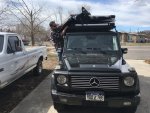inexplorata
Member
No one seems to have gone over these, so here’s my experience with them and a boatload of pictures. Long story short, I like the tent a lot. It’s solved all the problems I’ve had with rooftop tents I’ve owned in the past, and it seems to be built really, really well.
After a couple years of my wife, kiddo and I in our Tepui, we sold it and were going to be ground tent and cot people. I’d complained about how much fiddling I had to do with the rooftop tent, between spring poles and zippers and what-not, and with a tall rig like ours I was climbing around way too much. Plus the girls were getting cold at night, and also complaining.
Then I saw these. The Freespirit tents seemed to take care of everything that had led me to abandon rooftop tents. So I ordered one never having put my hands on it, and we were off to the races.
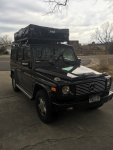
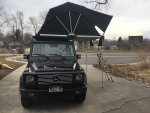
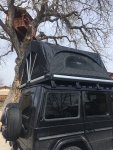
Mine is the High Country Series, Tri-Layer. The High Country tents are their clamshell ones, and they’re pretty interesting. Built with extruded aluminum framing, there’s a lot of stability for the weight. At 178 pounds, it’s lighter than my somewhat smaller Tepui Kukenam XL Ruggedized (210 pounds) and at 85”x52”x14” closed it’s bigger in every direction (Tepui was 72”x48”x12”). This means a huge mattress when open, which is great. That mattress is also slightly thicker, although it seems to get that way with two thinner mattresses put together that slide cleverly when the thing folds.
Things I loved:
- No spring poles. This was a big one for me. I have a tall rig, and in order to get around to all the spring poles on my Tepui I had to bring along a little ladder, stand on tires, hang off the roof rack and generally contort myself for ten minutes to get them all in place. This tent is 90% ready when you open it up, the remaining 10% being getting the little awning in place. That goes surprisingly smoothly, so maybe I’ll reduce that percentage to 5%.
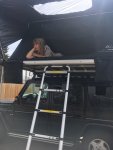
- Buckles instead of a zipper on the cover. This was something I thought at first was going to work out to be a wash, but I spent so much more time getting that Tepui zipper started than I do on this cover it’s not even funny. Also FreeSpirit has made the cover generously large, which makes getting it in place easier. And the buckle straps are great; an older model had snowboard-binding-style fasteners I thought I was getting, but these buckles are even better I think. Clip them together and tighten them and you’re set.
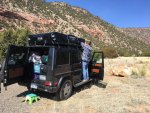
- The Tri-Layer stuff. I thought this a bit gimmicky, but it’s not. It’s awesome. I set up a dual temperature gauge, with just the three of us inside by morning the air in the tent was 10-15 degrees warmer than the outside air. Also the multiple layers seem to have solved the condensation problem handily — zero condensation. Snug as bugs, it feels well put together and cozy as all get-out.
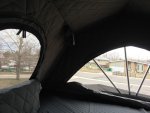
- Integrated shoe bags. Of course it’s very little effort to make your own, but these are perfect. They have little drawstrings and flaps for when it’s dumping rain, and tiny grommet holes in the bottom for dirt to fall out.
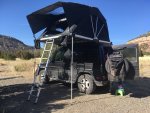
- Little zipper hole for power/etc. I've got a second battery in the truck, we run power up for various devices from a socket on the rear bumper. It's perfectly positioned, and a nice thought.
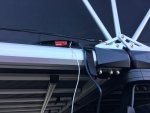
- Stabilizer poles. Another thing I wasn’t sure about, but they make a real difference on a large tent like this. I wanted to complain about the way they extended, but I was just being an idiot, it’s simple and effective with little spring buttons on the inner pole and holes in the outer.
Things I didn’t love:
- It’s big. And of course that’s a plus as well, when you think about it. The problem with the larger size is just my own setup; it takes up ALL of my Front Runner rack, and sits so low on regular tent mounts I couldn’t buckle the cover. Mounting it slightly higher of course solved that. But at the end of the day I have no more room on top to store things, which is something I’m adjusting to. And the lighter weight of the Freespirit means it ends up “feeling” smaller when you’re driving around.
- Poor documentation. The instruction manual was clearly written in China and loosely translated into English. I figured it all out, because it’s not my first rodeo and we’re not exactly sending people to the moon here, but at the price point I’d like to see at least some local effort put into instructions being clear and less absurd-sounding.
- “That’s not a wrench.” Similarly, the toolkit provided, while nice looking, is cheap. I have my own tools, so again no biggie, but at the price…
- Different sort of ladder. This is another pretty minor complaint, but the ladder provided is a little different than the one that came with my Tepui, particularly when closing it up. With the Tepui, there were a couple of red latches under the bottom rung, and when you depressed those the whole thing would collapse itself sequentially. This meant that when I was closing the whole thing up I could practically toss the ladder into place on top of my rig. The Freespirit choice was one where every rung needs to be collapsed individually — and you need to depress levers on both sides of each rung, which means both hands, which means careful planning at the end of the folding process. A little fiddly, although I expect it’s less likely to collapse when I’m standing on it, which is probably a good thing.
Bottom line:
I’m pretty pleased so far. We did a week on the road with it down to New Mexico and it’s a great tent for my requirements. We've got a two-week trip set for this summer and I'm confident in the tent, at least. I always told people the Tepui was the best-made tent I’d ever owned — which is saying something because I’m kind of old and I’ve been tenting forever — and I’ll say the Freespirit seems to be even better-made at a very similar price. Time will tell, of course.
If anyone has any questions I’ll do my best to answer them.
After a couple years of my wife, kiddo and I in our Tepui, we sold it and were going to be ground tent and cot people. I’d complained about how much fiddling I had to do with the rooftop tent, between spring poles and zippers and what-not, and with a tall rig like ours I was climbing around way too much. Plus the girls were getting cold at night, and also complaining.
Then I saw these. The Freespirit tents seemed to take care of everything that had led me to abandon rooftop tents. So I ordered one never having put my hands on it, and we were off to the races.



Mine is the High Country Series, Tri-Layer. The High Country tents are their clamshell ones, and they’re pretty interesting. Built with extruded aluminum framing, there’s a lot of stability for the weight. At 178 pounds, it’s lighter than my somewhat smaller Tepui Kukenam XL Ruggedized (210 pounds) and at 85”x52”x14” closed it’s bigger in every direction (Tepui was 72”x48”x12”). This means a huge mattress when open, which is great. That mattress is also slightly thicker, although it seems to get that way with two thinner mattresses put together that slide cleverly when the thing folds.
Things I loved:
- No spring poles. This was a big one for me. I have a tall rig, and in order to get around to all the spring poles on my Tepui I had to bring along a little ladder, stand on tires, hang off the roof rack and generally contort myself for ten minutes to get them all in place. This tent is 90% ready when you open it up, the remaining 10% being getting the little awning in place. That goes surprisingly smoothly, so maybe I’ll reduce that percentage to 5%.

- Buckles instead of a zipper on the cover. This was something I thought at first was going to work out to be a wash, but I spent so much more time getting that Tepui zipper started than I do on this cover it’s not even funny. Also FreeSpirit has made the cover generously large, which makes getting it in place easier. And the buckle straps are great; an older model had snowboard-binding-style fasteners I thought I was getting, but these buckles are even better I think. Clip them together and tighten them and you’re set.

- The Tri-Layer stuff. I thought this a bit gimmicky, but it’s not. It’s awesome. I set up a dual temperature gauge, with just the three of us inside by morning the air in the tent was 10-15 degrees warmer than the outside air. Also the multiple layers seem to have solved the condensation problem handily — zero condensation. Snug as bugs, it feels well put together and cozy as all get-out.

- Integrated shoe bags. Of course it’s very little effort to make your own, but these are perfect. They have little drawstrings and flaps for when it’s dumping rain, and tiny grommet holes in the bottom for dirt to fall out.

- Little zipper hole for power/etc. I've got a second battery in the truck, we run power up for various devices from a socket on the rear bumper. It's perfectly positioned, and a nice thought.

- Stabilizer poles. Another thing I wasn’t sure about, but they make a real difference on a large tent like this. I wanted to complain about the way they extended, but I was just being an idiot, it’s simple and effective with little spring buttons on the inner pole and holes in the outer.
Things I didn’t love:
- It’s big. And of course that’s a plus as well, when you think about it. The problem with the larger size is just my own setup; it takes up ALL of my Front Runner rack, and sits so low on regular tent mounts I couldn’t buckle the cover. Mounting it slightly higher of course solved that. But at the end of the day I have no more room on top to store things, which is something I’m adjusting to. And the lighter weight of the Freespirit means it ends up “feeling” smaller when you’re driving around.
- Poor documentation. The instruction manual was clearly written in China and loosely translated into English. I figured it all out, because it’s not my first rodeo and we’re not exactly sending people to the moon here, but at the price point I’d like to see at least some local effort put into instructions being clear and less absurd-sounding.
- “That’s not a wrench.” Similarly, the toolkit provided, while nice looking, is cheap. I have my own tools, so again no biggie, but at the price…
- Different sort of ladder. This is another pretty minor complaint, but the ladder provided is a little different than the one that came with my Tepui, particularly when closing it up. With the Tepui, there were a couple of red latches under the bottom rung, and when you depressed those the whole thing would collapse itself sequentially. This meant that when I was closing the whole thing up I could practically toss the ladder into place on top of my rig. The Freespirit choice was one where every rung needs to be collapsed individually — and you need to depress levers on both sides of each rung, which means both hands, which means careful planning at the end of the folding process. A little fiddly, although I expect it’s less likely to collapse when I’m standing on it, which is probably a good thing.
Bottom line:
I’m pretty pleased so far. We did a week on the road with it down to New Mexico and it’s a great tent for my requirements. We've got a two-week trip set for this summer and I'm confident in the tent, at least. I always told people the Tepui was the best-made tent I’d ever owned — which is saying something because I’m kind of old and I’ve been tenting forever — and I’ll say the Freespirit seems to be even better-made at a very similar price. Time will tell, of course.
If anyone has any questions I’ll do my best to answer them.

